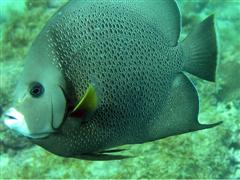Angelfish gray
Grey Black Angelfish Scientific Name: Pomacanthus arcuatus
Thu, 10th July, 2025 - 2:29 am GMT
Sponsor Ads:

Alternative Name
Grey Black Angelfish Scientific Name: Pomacanthus arcuatusBasic Info
A mature Gray Angel may have grown 10 to 24 inches (25 to 60 centimeters) long. These large fish are, as their name indicates, grayish-brown to gray in coloring. This brown shading in Gray Angels is often achieved through the shading of individual scales; many are gray with brown areas in the middle, and often the edges of each scale are brown. Lighter gray or whitish shades mark the mouth and the straight outer edge of the caudal fin. The inside of each long pectoral fin is yellowish. The tail has a squared shape. Gray Angels have smooth-edged spines at the corner of each of their preopercle bones. This spine has a serrated edge in juveniles. Juvenile Gray Angels are quite different in coloring from adults. These fish have black coloring with a concavely rounded yellow caudal fin and light yellow bars. Over the body, two such bars are present, and three may be seen on the head. One of these yellow bands runs all the way through the Gray Angel's mouth. The juvenile Gray Angel's caudal fin is marked with a black dot, which may be vertically elongated or rectangular. The general body shape of a Gray Angel is round, and the mouths are small, with the lower jaw protruding beyond the upper jaw. There are filaments, or prolonged protrusions, extending from both the anal and dorsal fins of Gray Angels.
Health
A single Gray Angel Fish should have an aquarium of at least 140 gallons. Temperatures in the enclosure should remain in the upper 70 degrees Fahrenheit, though a range between 72 and 78 degrees (23 to 26 degrees Celsius) is acceptable. The pH value should remain at 8.3 or 8.4, and the specific gravity should register between 1.020 and 1.025. The upper part of this range, 1.023 to 1.025, would be appropriate for a tank containing invertebrates, which need higher salinities, though a fish-only aquarium could remain at the lower part of that range. Plenty of open swimming space and secluded hiding places should be provided. Gray Angels usually do not tolerate other similar fish. They may eat or bite clam mantles and hard or soft corals. It is important to feed Gray Angels a variety of foods to ensure proper nutrition. Often algae, sponges, meats, vegetable bits, or prepared Angelfish food are offered. Breeding Although some Gray Angels have been bred in captivity, the process is particularly difficult. Female Gray Angels usually select a male, once they are gravid. The pair swims to the surface of the water and each Angel releases eggs or sperm, which combine in the water. In the wild, the tiny Angels develop in floating beds of plankton. Once they are large enough to swim down toward a reef environment, they leave their surface habitats.Habitat
Saltwater fish - They are found from the eastern coast of the United States down through Rio de Janeiro in Brazil, including populations in the West Indies.Behavior
The beautiful Gray Angel is a striking fish, despite its more subdued adult coloration. These large Angels are a delight to both divers and aquarists. Although most Gray Angel Fish are found alone in the wild, some pair up. In a home aquarium, the tank may be too small to allow for these territorial fish to be combined; if you do hope to try it, it is important to observe the fish carefully lest they attack each other. In a reef environment, a Gray AngelFish should also be watched for signs that it is nipping at clam mantles or hard or soft corals. In the wild, such organisms are a natural food, supplemented with a variety of other organisms, especially sponges. Seagrasses are also sometimes consumed. Normally, Gray Angels are found near reefs at depths between two and 30 meters (7 to 99 feet).Origin
Atlantic OceanHistory
Many Gray Angels intended for the pet trade are collected from the Caribbean, though their range includes much of the western Atlantic. Many divers are particularly charmed with Gray Angels, who have been reported to approach these people.Common Foods
N/ASponsor Ads:
"Too frequent rewards signify that the enemy is at the end of his resources; too many punishments betray a condition of dire distress." -- Sun Tzu, The Art of War
Angelfish gray
Coded by: BGID® | ALL RIGHTS RESERVED Copyright © 2000-2025
Disclaimer | Privacy | Report Errors / Contact | Credits








 Preparing For China. China is growing their military. China Military Technology - can it keep up with the US?
Preparing For China. China is growing their military. China Military Technology - can it keep up with the US?  versus
versus 

 versus
versus 
 This Thread is about the North Korean Military itself - the kind of army, navy, and air force they have.
This Thread is about the North Korean Military itself - the kind of army, navy, and air force they have. 
 versus
versus 
 versus
versus  versus
versus